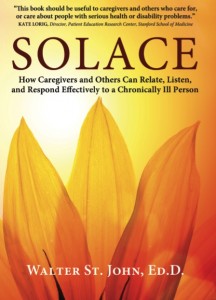 SOLACE–How Caregivers and Others can Relate, Listen, and Respond Effectively to a Chronically Ill Person, by Walter St. John, EdD.
SOLACE–How Caregivers and Others can Relate, Listen, and Respond Effectively to a Chronically Ill Person, by Walter St. John, EdD.
Solace offers a wealth of information that at first pass might intimidate the overwhelmed caregiver.
However, if the book is used as a resource guide for specific communication tips and strategies, busy caregivers will find it of value.
As a caregiver for my mom with breast cancer and a volunteer for several organizations, I benefit most when the tips are easily accessible.
In “Responding to Repetitive Statements,” author St. John writes, “It is a bad idea to merely ignore and dismiss repetitive comments or questions. Such a reaction is unkind and lacks compassion.” (Chapter 57, page 260)
Reading this inspires me to discover the real issue behind a statement Mom routinely repeats, “It’s a pain.”
When I ask her, “What hurts?” she replies, “Nothing hurts.”
I’m beginning to believe her “pain” comment means that her cancer is more of a nuisance, now.
Another example of tips that are easily accessible is in “Being Humorous” (Chapter 37, page 169), where St. John observes, “Shared laughter creates a feeling of togetherness.” And he adds, “Laughter is healing — it makes all people feel better.”
Oh joy! Even if it seems ghoulish to others, all our laughing about illness and death is good for both of us; so, Mom and I will keep on laughing.
The more time I spend looking through the pages of Solace, the better suited it seems as asupplemental resource in a communications workshop or seminar. Some examples go beyond caregiving; especially, for a chronically ill person with dementia, a victim of a paralyzing stroke, or one with another debilitating illness.
In “Observing Body Language” (Chapter 32), St. John details many physical indicators to observe for more accurate cues as to the meaning of the spoken word. These rules for body language help us interact better in everyday life.
Body language clues are deceptive when patients are lying in bed and cannot sit up let alone lean in to show interest in what a conversational companion is saying. Even the example of excessive eye blinking may mean nothing more than dry eyes. Voice pitch doesn’t help if the patient is too weak to be heard beyond a whisper. These are some of the realities of caring for chronically ill patients.
Solace is loaded with so much information, as a busy caregiver and volunteer, I struggled to retain enough of it to be useful.
In “Listening to the Whole Person” (chapter 35, page 163), St. John writes, “Effective listeners use the following recommended techniques for listening to ill people….” He follows with a list of 15-bullet points. Not one of them made enough of a lasting impression that I could apply it.
The same overwhelming list follows in “Developing Trust” (chapter 42, page 195), “There are many things you can do to develop trust….” Again, the author follows with 19-bullet points.
We caregivers are dealing with an ill relative. We know this person and for the most part they already trust us. We know their personality traits and what emotional issues not to talk about.
Nurses can apply key learning in Solace when dealing with diverse personalities. This is true for any professional working with any group.
I believe St. John limits his reach by targeting just caregivers of the chronically ill. Solace appears well-suited for those who want to connect better with others and improve their communication skills will benefit from reading Solace.
Kathleen Parenteau
The Caregiver’s Voice Guest Reviewer








